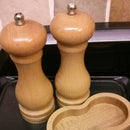Introduction: Styrene LED Strip Brackets
I bought a strip of Adafruit's RBG LEDs from Phenoptix. They come with a protective silicone sheath to stop moisture damaging them or metal shorting the pads. This is great but makes them pretty tricky to mount since it rules out tape or most glues.
I wanted a semi-permanent method to mount my LED strip. I could have 3d printed or bent some aluminium brackets, but ever since watching a YouTube video of Jimmy DiResta using styrene to make a box, I've found it hugely useful for making small items.
Styrene for enclosures and fixtures is a great material. It can be cut incredibly cleanly and easily with just a score of a knife followed by snapping along the score. It can be scraped, sanded, polished, painted and glued. Following Jimmy's recommendation I use DCM as a solvent to dissolve two styrene surfaces, attaching them very strongly within several seconds. I've made joins with DCM and tried to separate them later, only for the Styrene to tear around the joint not at the joint.
Read on for instructions on how to make these super quick and easy styrene brackets.
Step 1: Cut Strips
First, cut two strips of styrene, one 5 mm wide and one 10 mm wide. I chose 1.5 mm thick styrene purchased from eBay.
A set of vernier calipers is useful to mark the position of the cut on the stock. Alternatively a compass can be used to leave a mark equidistant along the edge with a pencil.
Lay the ruler over the cut position and score the styrene firmly once or twice.
Bend the scored piece backwards, it should snap off with a satisfyingly clean snap. The edges should be neat and free of burrs, but you might like to reduce the sharp corner by running the blade over it, held perpendicular to the surface.
Step 2: Cut Some Blanks
Decide how many brackets you require, then cut as many 30 mm long pieces as you need from the 10 mm wide strip.
Step 3: Cut and Glue Standoffs
Cut pieces 10 mm x 5 mm from your second strip. You'll need twice as many of these as you cut 30 mm blanks.
Stick your standoffs as shown in the photo with one on the edge and another set approximately 15 mm from the same edge. The DCM used to stick them on evaporates fast so use either a needle applicator or a non-synthetic brush, keeping the lid closed. Superglue may be used as an alternative but DCM effectively makes it seamless. Once applied and the two parts pressed together the DCM should set in < 5 seconds.
Step 4: Add Final Piece
I added this last piece to ensure that the LED strip doesn't slip out. I didn't want just 3 uprights since this way I can remove the LED strip without fully unscrewing the brackets.
Step 5: Drill Hole
Drill a 4 mm mounting hole between the two standoffs. Deburr it with a hand-twist of a larger drill bit (10 mm for example).
Step 6: Attach
The brackets may now be screwed into wood using self tapping screws. For mounting to a metal or plastic surface, first drill an appropriately sized pilot hole.

Participated in the
Epilog Challenge VI













